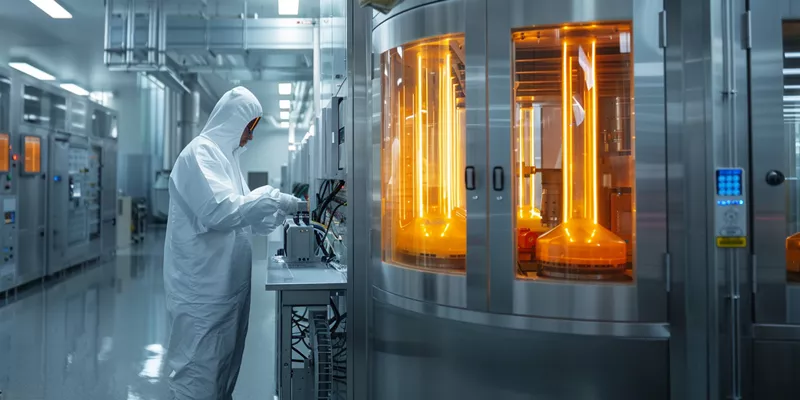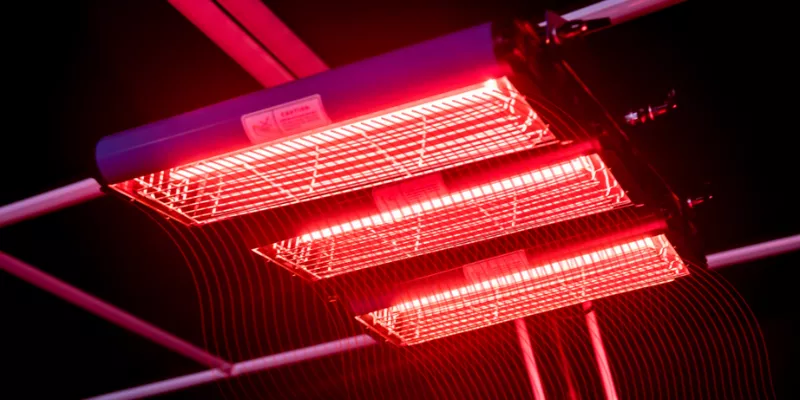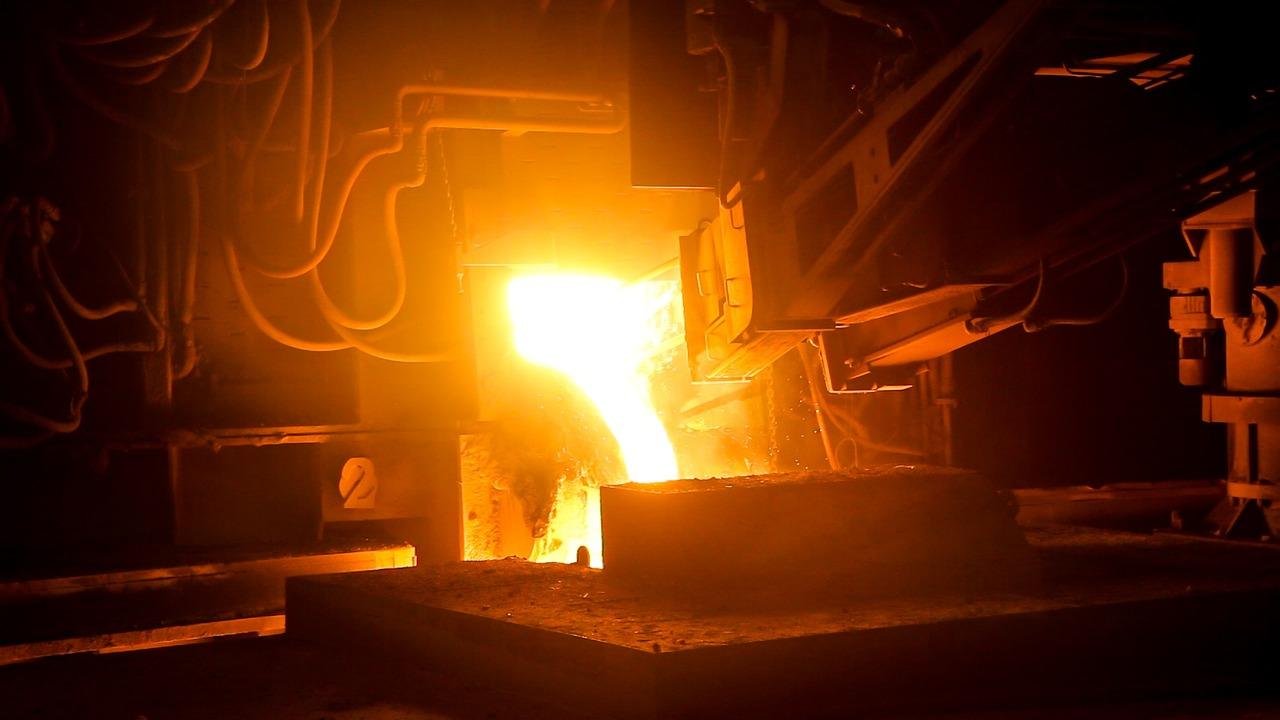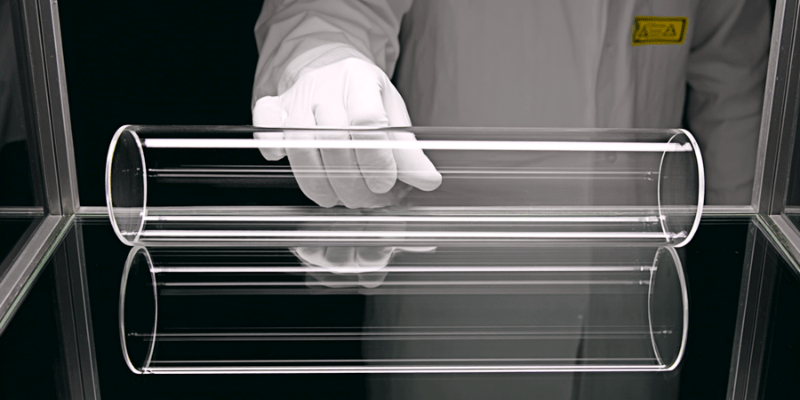Selecting the right quartz glass manufacturing process is a significant engineering challenge for industries requiring high-performance materials.
Quartz glass manufacturing involves three main processes: melting high-purity silica at temperatures exceeding 2000°C, forming the material into desired shapes through continuous or discontinuous methods, and annealing to relieve internal stress. The choice between flame fusion, electric melting, or sol-gel processes depends on the required purity level and final application requirements.

Understanding the manufacturing process is essential for making informed decisions about material selection, performance, and supplier evaluation. The following sections explore each aspect in detail, from process fundamentals to practical procurement strategies.
How is Quartz Glass Produced?
Industries face complex requirements when sourcing materials for demanding environments.
Quartz glass manufacturing refers to the controlled transformation of high-purity silicon dioxide into amorphous glass through high-temperature processes. This process is crucial because it determines the material's purity, optical clarity, and resistance to thermal shock.

Quartz glass is valued for its exceptional thermal stability, chemical resistance, and optical properties. These characteristics are directly influenced by the manufacturing process, making it essential for applications in semiconductors, optics, and laboratory equipment.
Key Aspects of Quartz Glass Manufacturing
| Aspect | Description |
|---|---|
| Raw Material | High-purity silica (SiO₂) |
| Melting Temperature | >2000°C |
| Forming Methods | Continuous, discontinuous, or sol-gel |
| Purity Control | Removal of metallic and gaseous impurities |
| Applications | Semiconductors, UV optics, laboratory ware, high-temperature components |
Why is Manufacturing Process Critical for Quartz Glass Quality?
Achieving consistent performance in demanding applications requires precise process control.
The manufacturing process directly impacts quartz glass quality by influencing impurity levels, microstructure, and mechanical properties. For example, flame fusion may introduce metallic impurities, while electric melting offers higher purity but at increased cost.
Process selection affects optical transmission, thermal expansion, and resistance to devitrification. Manufacturers must balance cost, throughput, and quality to meet application-specific requirements.
Manufacturing Process Impact on Key Properties
| Property | Flame Fusion | Electric Melting | Sol-Gel |
|---|---|---|---|
| Purity (SiO₂, %) | 99.95–99.98 | 99.99–99.999 | 99.99+ |
| Optical Transmission (%) | 85–90 (UV) | 90–95 (UV) | 92–96 (UV) |
| Bubble Content (pcs/cm³) | 10–20 | 1–5 | <1 |
| Cost Index | Low | Medium–High | High |
What Are the Key Manufacturing Methods for Quartz Glass?
Choosing the optimal manufacturing method is a pivotal step in aligning material properties with end-use requirements.
Quartz glass can be produced using several methods, each with unique advantages and limitations. The three primary techniques are flame fusion, electric melting, and sol-gel processing.

Each method yields different purity levels, structural characteristics, and cost profiles, making process selection a critical decision for engineers and procurement specialists.
Overview of Quartz Glass Manufacturing Methods
| Method | Max Temperature (°C) | Typical Purity (%) | Main Applications | Cost Level |
|---|---|---|---|---|
| Flame Fusion | 2000–2200 | 99.95–99.98 | Lighting, general labware | Low |
| Electric Melting | 2000–2300 | 99.99–99.999 | Semiconductors, optics | Medium–High |
| Sol-Gel | <1500 | 99.99+ | Specialty optics, coatings | High |
Flame Fusion Process
Flame fusion is often selected for its cost efficiency and scalability.
Flame fusion involves melting high-purity silica sand using a gas-oxygen flame, then shaping the molten material into quartz tubes, rods, or plates. This method is widely used for producing standard quartz glass products where ultra-high purity is not critical.
Flame fusion is suitable for applications such as UV lamps, general laboratory glassware, and some industrial components. However, it may introduce trace metallic impurities and bubbles, which can affect optical and mechanical performance.
Electric Melting Process
Electric melting is preferred when high purity and superior optical properties are required.
In electric melting, silica is melted in a platinum or ceramic crucible using electric resistance or induction heating. This process minimizes contamination, resulting in quartz glass with higher purity and fewer inclusions.
Electric melting is commonly used for semiconductor substrates, high-precision optical components, and applications demanding stringent quality standards. The process is more expensive due to equipment and energy costs but delivers superior material performance.
Sol-Gel Process
The sol-gel process is chosen for specialty applications requiring tailored microstructures.
Sol-gel manufacturing involves hydrolyzing silicon alkoxides to form a colloidal suspension (sol), which then gels and is dried and sintered at lower temperatures. This method allows precise control over composition and porosity.
Sol-gel quartz glass is used in advanced optics, coatings, and research applications where unique properties are needed. The process is complex and costly, limiting its use to niche markets.
How Do Different Raw Materials Affect Manufacturing Outcomes?
Material selection is a foundational decision that shapes the entire manufacturing process.
The choice of raw materials—natural quartz, synthetic silica, or high-purity sand—affects the achievable purity, optical clarity, and mechanical strength of the final product. Impurities in the starting material can lead to color centers, reduced UV transmission, and lower thermal stability.
Manufacturers often use synthetic silica for high-end applications, while natural quartz is suitable for less demanding uses. The selection process must consider both cost and performance requirements.
Raw Material Impact on Quartz Glass Properties
| Raw Material | Typical Purity (%) | UV Transmission (%) | Thermal Stability (°C) | Main Use Cases |
|---|---|---|---|---|
| Natural Quartz | 99.5–99.8 | 80–85 | 1100–1200 | General industrial, lighting |
| High-Purity Sand | 99.8–99.99 | 85–90 | 1200–1300 | Laboratory, standard optics |
| Synthetic Silica | 99.99–99.999 | 90–95 | 1300–1500 | Semiconductors, high-end optics |
Which Applications Require Specific Manufacturing Approaches?
Matching manufacturing methods to application requirements is essential for optimal performance.
Certain industries, such as semiconductors and UV optics, demand quartz glass with ultra-high purity and minimal defects. In these cases, electric melting or sol-gel processes are preferred. For general laboratory or industrial use, flame fusion may suffice.
Selecting the right process ensures the material meets performance, durability, and regulatory standards for its intended use.
Application-Specific Manufacturing Method Selection
| Application Area | Required Purity (%) | Preferred Method | Key Performance Criteria |
|---|---|---|---|
| Semiconductor Wafers | 99.999 | Electric Melting | Low impurity, high homogeneity |
| UV Optics | 99.99+ | Electric Melting/Sol-Gel | High UV transmission |
| Laboratory Equipment | 99.95–99.99 | Flame Fusion | Chemical resistance, cost |
| High-Temp Crucibles | 99.98–99.99 | Flame Fusion/Electric Melting | Thermal shock resistance |
Continuous vs. Discontinuous Manufacturing: Which Process Delivers Better Results?
Selecting between continuous and discontinuous processes presents a significant engineering challenge.
Continuous manufacturing offers high throughput and consistent quality, while discontinuous (batch) processes allow for greater control over small production runs and specialty products. The choice impacts cost, scalability, and product uniformity.
Understanding the trade-offs between these approaches is essential for aligning production capabilities with application needs.
Process Comparison: Continuous vs. Discontinuous
| Parameter | Continuous Process | Discontinuous Process |
|---|---|---|
| Throughput (kg/h) | 100–500 | 10–100 |
| Purity Control | Moderate | High |
| Cost Efficiency | High | Medium–Low |
| Customization | Limited | High |
| Typical Applications | Standard tubes, rods | Specialty optics, custom parts |
Continuous Process Advantages?
Continuous processes are ideal for large-scale, standardized production.
They enable high-volume output with consistent dimensions and properties, making them suitable for products like quartz tubes and fused silica rods used in lighting and industrial heating. Automation reduces labor costs and improves repeatability.
Discontinuous Process Benefits?
Discontinuous processes excel in flexibility and quality control.
Batch production allows for precise adjustment of process parameters, resulting in higher purity and better control over microstructure. This approach is favored for custom components, specialty optics, and applications where small quantities and stringent specifications are required.
How Do Manufacturing Methods Compare in Terms of Quality and Cost?
Navigating conflicting data requires a clear understanding of the underlying principles.
Manufacturing methods differ significantly in both quality and cost. Flame fusion is cost-effective but may compromise on purity, while electric melting and sol-gel offer superior properties at higher prices. The optimal choice depends on balancing performance requirements with budget constraints.

Engineers and procurement teams should evaluate both direct and indirect costs, including potential yield losses due to defects or suboptimal material performance.
Quality and Cost Comparison of Manufacturing Methods
| Method | Purity (SiO₂, %) | Optical Transmission (%) | Cost per kg (USD) | Typical Defect Rate (%) |
|---|---|---|---|---|
| Flame Fusion | 99.95–99.98 | 85–90 | 10–20 | 2–5 |
| Electric Melting | 99.99–99.999 | 90–95 | 25–50 | <1 |
| Sol-Gel | 99.99+ | 92–96 | 50–100 | <0.5 |
What Are the Critical Cost Factors in Quartz Glass Manufacturing?
Cost analysis is a vital step in procurement and project planning.
Key cost drivers include raw material purity, energy consumption, equipment depreciation, labor, and yield rates. High-purity materials and advanced melting technologies increase costs but may be justified by improved performance and reduced defect rates.

Understanding these factors enables more accurate budgeting and supplier negotiations.
Breakdown of Quartz Glass Manufacturing Costs
| Cost Component | Typical Share (%) | Notes |
|---|---|---|
| Raw Materials | 30–50 | Higher for ultra-pure grades |
| Energy | 20–30 | Melting at >2000°C is energy-intensive |
| Equipment Depreciation | 10–20 | Platinum crucibles increase costs |
| Labor | 10–15 | Automation reduces this share |
| Yield Losses | 5–10 | Defects and breakage during processing |
How to Evaluate Manufacturing Capabilities When Selecting Suppliers?
Supplier evaluation is a critical component of risk management and quality assurance.
Assessing a supplier's manufacturing capabilities involves reviewing their process technologies, quality certifications, production capacity, and track record with similar applications. Site audits and sample testing are recommended for high-stakes projects.
Requesting detailed process documentation and test reports helps ensure the supplier can meet your technical and delivery requirements.
Supplier Capability Evaluation Criteria
| Evaluation Aspect | Key Questions to Ask | Evidence to Request |
|---|---|---|
| Process Technology | Which melting/forming methods are used? | Process flowcharts, equipment list |
| Purity Control | How is impurity removal verified? | Test reports, certificates |
| Production Capacity | What is the maximum batch/continuous output? | Production records |
| Quality Certifications | Are ISO or industry standards met? | ISO 9001, relevant certificates |
| Application Experience | Has the supplier served similar industries? | Reference projects, client list |
What Quality Control Standards Should You Expect from Manufacturers?
Quality control standards are essential for ensuring product consistency and reliability.
Manufacturers should implement rigorous inspection protocols, including raw material analysis, in-process monitoring, and final product testing. Compliance with international standards such as ISO 9001 and ASTM specifications is a strong indicator of quality commitment.
Buyers should expect full traceability, batch documentation, and access to test data for each shipment.
Typical Quality Control Measures in Quartz Glass Manufacturing
| QC Stage | Test/Inspection Performed | Standard/Method | Frequency |
|---|---|---|---|
| Raw Material | Chemical purity analysis | ICP-OES, XRF | Each batch |
| Melting/Forming | Temperature & atmosphere control | Process logs | Continuous |
| Final Product | Optical transmission, bubble count | UV-Vis, microscopy | Each lot |
| Documentation | Batch traceability | ISO 9001, internal SOPs | All shipments |
Decision Framework for Selecting Quartz Glass Manufacturing Methods
Making an informed choice requires a structured evaluation of process, application, and supplier factors.
This decision framework guides engineers and procurement teams through the key questions and criteria for selecting the optimal manufacturing method and supplier.
Quartz Glass Manufacturing Decision Checklist
| Step | Key Question | Recommended Action |
|---|---|---|
| 1 | What is the required purity and performance? | Define application-specific criteria |
| 2 | Which manufacturing methods meet these needs? | Compare flame fusion, electric melting, sol-gel |
| 3 | What is the acceptable cost range? | Balance quality with budget constraints |
| 4 | Which suppliers offer proven capabilities? | Review certifications, process documentation |
| 5 | Are quality control standards documented? | Request test reports and traceability information |
| 6 | Is customization or small batch needed? | Consider discontinuous/batch processes |
| 7 | Can the supplier provide technical support? | Evaluate engineering and after-sales services |
Conclusion
Quartz glass manufacturing methods must be matched to application needs for optimal results.
Navigating the complexities of quartz glass manufacturing requires both technical insight and reliable partners. Leverage TOQUARTZ's factory-direct supply, engineering support, and rapid delivery to ensure your project benefits from high-purity materials and expert guidance—contact us for a tailored consultation on your quartz glass requirements.
FAQ (Frequently Asked Questions)
What is the difference between fused quartz and fused silica?
Fused quartz is made from natural quartz, while fused silica is produced from synthetic precursors. Fused silica typically offers higher purity and better UV transmission.
How can I verify the purity of quartz glass from a supplier?
Request chemical analysis reports, such as ICP-OES or XRF data, and review the supplier's quality certifications to ensure compliance with your requirements.
What are the risks of using lower-cost manufacturing methods?
Lower-cost methods like flame fusion may introduce more impurities and defects, potentially reducing optical performance and increasing the risk of failure in demanding applications.
What should I include in a supplier evaluation checklist for quartz glass procurement?
Include process technology, purity control, production capacity, quality certifications, and experience with similar applications. Always request supporting documentation and test data.





